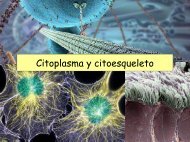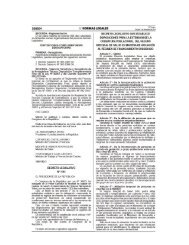Anticoagulacion
You also want an ePaper? Increase the reach of your titles
YUMPU automatically turns print PDFs into web optimized ePapers that Google loves.
64<br />
Anticoagulación en enfermedad cerebrovascular<br />
entre autoanticuerpos antifosfolípidos y accidente<br />
vascular cerebral en pacientes sin lupus.<br />
Como puede notarse, el término anticoagulación oral<br />
ha sido usado aquí como sinónimo de anticoagulación<br />
con warfarina debido a que por décadas no ha sido puesto<br />
en uso clínico un agente anticoagulante oral que ofrezca<br />
ventajas claras frente a los viejos cumarínicos. El<br />
ximelagatrán es un agente nuevo, inhibidor directo de la<br />
trombina, de administración oral, que es biotransformado<br />
en melagatrán; esta sustancia inhibe la trombina libre y la<br />
ya unida al coágulo, y reduce la agregación y activación<br />
plaquetarias inducidas por la trombina (52). Posee una<br />
excelente biodisponibilidad, su vida media es de 12<br />
horas y no necesita monitoreo de anticoagulación.<br />
Ximelagatrán ha sido estudiado para fibrilación auricular<br />
en dos importantes estudios de fase III (SPORTIF III<br />
y V). El SPORTIF III (53) ha sido recientemente publicado<br />
y prueba warfarina frente a ximelagatrán (36 mg dos<br />
veces al día) en 3.410 pacientes con fibrilación auricular<br />
y al menos un factor de riesgo. Los resultados demostraron<br />
que el ximelagatrán tiene igual efectividad que la<br />
warfarina en la prevención del accidente vascular cerebral,<br />
con una reducción del riesgo absoluto del 0,7 (95%<br />
con insuficiencia cardíaca -0,1 - 0,4). Los porcentajes<br />
de sangrado fueron similares entre los dos grupos, pero<br />
la combinación de sangrado menor y mayor fue más<br />
bajo con el ximelagatrán (29,8% vs. 25% (p = 0,007).<br />
El SPORTIF V (54) de similar diseño y doble ciego,<br />
incluyó 3.992 pacientes y demostró una reducción del<br />
riesgo absoluto del 0,7% a favor de la warfarina (p =<br />
0,13). Infortunadamente, ximelagatrán se ha asociado<br />
con un aumento de las transaminasas en cerca de 6% de<br />
los pacientes, lo cual es transitorio y autolimitado, sin<br />
embargo, ha sido suficiente para generar cautela en las<br />
autoridades norteamericanas que, contrario a las europeas,<br />
han aplazado su aprobación hasta el momento de<br />
redactar este capítulo.<br />
Bibliografía<br />
1. Adams HP Jr, Brott TG, Crowell RM, et al. Guidelines for<br />
the management of patients with acute ischemic stroke: a<br />
statement for healthcare professionals from special writing<br />
group of the Stroke Council, American Heart Association.<br />
Circulation 1994; 90: 1588-1601.<br />
2. Adams HP Jr, Chair, Adams RJ, Brott T, del Zoppo GJ,<br />
Furlan A, Goldstein LB, et al. Guidelines for the early<br />
management of patients with ischemic stroke: a scientific<br />
statement from the Stroke Council of the American Stroke<br />
Association. Stroke 2003; 34: 1056-1083.<br />
3. International Stroke Trial Collaborative Group. The<br />
International Stroke Trial (IST): a randomized trial of aspirin,<br />
subcutaneous heparin, both, or neither among 19.435<br />
patients with acute ischaemic stroke. Lancet 1997; 349:<br />
1569-1581.<br />
4. Duke RJ, Bloch FG, Turpie AGG, et al. Intravenous heparin<br />
for the prevention of stroke progression in acute partial<br />
stable stroke: a randomized controlled trial. Ann Intern<br />
Med 1986; 105: 825-828.<br />
5. Kay R, Sing Wong K, Yu YL, et al. Low-molecular-weight<br />
heparin for the treatment of acute ischemic stroke. N Engl<br />
J Med 1995; 333: 1588-1593.<br />
6. Hommel M, FISS bis Investigators Group. Fraxiparine in<br />
Ischemic Stroke Study (FISS bis). Cerebrovasc Dis 1998; 8<br />
(suppl 4): 19A.<br />
7. Publications Committee for the Trial of ORG 10172 in<br />
Acute Stroke Treatment (TOAST) Investigators. Low<br />
molecular weight heparinoid, ORG 10172 (Danaparoid),<br />
and outcome after acute ischemic stroke. JAMA 1998;<br />
279: 1265-1272.<br />
8. Berge E, Abdelnoor M, Nakstad PH, Sandset PM, on behalf<br />
of the HAEST Study Group. Low molecular-weight heparin<br />
versus aspirin in patients with acute ischaemic stroke and<br />
atrial fibrillation: a double-blind randomised study. Lancet<br />
2000; 355: 1205-1210.<br />
9. Diener HC, Ringelstein EB, von Kummer R, et al. Treatment<br />
of acute ischemic stroke with the low-molecular-weight<br />
heparin certoparin. Results of the TOPAS Trial. Stroke 2001;<br />
32: 22-29.<br />
10. Bath PMW, Lindenstrom E, Boysen G, et al. Tinzaparin in<br />
acute ischaemic stroke (TAIST): a randomized aspirincontrolled<br />
trial. Lancet 2001; 358: 702-710.<br />
11. Gubitz G, Counsell C, Sandercock P, et al. Anticoagulants<br />
for acute ischemic stroke (Cochrane Review). In: The<br />
Cochrane Library, Issue 1, 2000. Oxford.<br />
12. CAST (Chinese Acute Stroke Trial) Collaboration Group.<br />
CAST: randomized placebo-controlled trial of early aspirin<br />
use in 20,000 patients with acute ischaemic stroke. Lancet<br />
1997; 349: 1641-1649.<br />
13. Duke RJ, Bloch FG, Turpie AGG, et al. Intravenous heparin<br />
for the prevention of stroke progression in acute partial<br />
stable stroke: a randomized controlled trial. Ann Intern<br />
Med 1986; 105: 825-828.<br />
14. McCarthy ST, Turner J. Low-dose subcutaneous heparin in<br />
the prevention of deep-vein thrombosis and pulmonary emboli<br />
following acute stroke. Age Ageing 1986; 15: 84-88.<br />
15. Counsell C, Sandercock P. Low-molecular-weight heparins<br />
or heparinoids versus standard unfractionated heparin for<br />
acute ischemic stroke. In: The Cochrane Library, Issue 1,<br />
2000. Oxford.<br />
http://booksmedicos.blogspot.com





